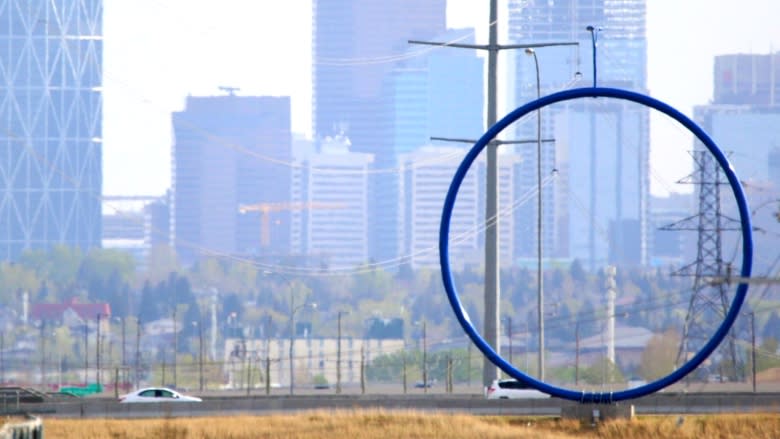Calgary's public art policy needs to adapt, panel told
A former politician, an artist and the head of a company that builds public art all agree that the city's public art program needs some sprucing up.
The program was up for discussion at a public form presented by the University of Calgary's School of Public Policy on Tuesday at the Fairmont Palliser hotel.
City council voted last September to suspend the program while it's reviewed.
That decision came following the public controversy about the Bowfort Towers, a public art installation on the city's western edge.
The ex-councillor
One of the people who voted to suspend the public art program was former city councillor Andre Chabot.
He told the forum he's always been troubled at how so much prominent art — like Bowfort Towers or Travelling Light (perhaps better known as the Big Blue Ring) — ends up at the side of busy roads.
Chabot, who ran unsuccessfully for mayor in last fall's municipal election, would like to see more art in parks or in other public spaces where people not in cars can take the time to appreciate it.
"To put something that's controversial right beside a high-speed roadway, to me, is just totally counter-intuitive," said Chabot.
"It doesn't really address the value of what art is supposed to be about."
He'd like to see more information about the public art program given to city council in an annual report, along the lines of how civic partners like Heritage Park or the Calgary Zoo inform council of their activities.
As well, the former councillor wants better public involvement on panels that select winning artists or projects.
He said joining those panels requires interested citizens submitting their resume and describing why they're interested in art.
"What about somebody who has no interest in art? Shouldn't they be allowed to sit on that committee? To help to guide the decision on ultimately what kind of art gets built? I think they should," said Chabot.
The artist
Caitlind Brown knows a bit about public art.
She and Wayne Garret are collaborating on several public art projects in Calgary right now.
She told the forum that public art controversies have been prominent in the past few municipal elections.
But last fall, Bowfort Towers seemed to alienate almost all Calgarians.
"It managed to simultaneously annoy people who are public art supporters for reasons of cultural appropriation and potential cultural appropriation and also people who are public art deniers," said Brown.
"People who don't like public art in the first place and think that it's too expensive. I think it really re-affirmed the way that they feel.
"It ended up becoming an icon for the election in this really fascinating way."
One thing she'd change about the city's public art program would be to allow greater communication — both by the city and by the artists.
Brown would like to see the public art program have a website separate from the city's site so not everything is filtered by the city's regular communications channels.
As well, artists should be allowed to talk about the vision they have for their work.
"Almost as soon as the artist is selected, it would be wonderful to hear them speak to their intentions," she said.
The builder
Ryan Bessant was another panellist at the forum.
He is the president of Heavy Industries, a Calgary firm that actually builds public artworks. As he puts it: "We turn big ideas into experiences."
The company has built 60 public art projects in the past five years. Of those, 40 have been privately-funded while the other 20 have been built with public dollars.
From his vantage point, there are things the publicly-funded projects could learn from the processes followed for privately-funded projects.
Most public art projects in the private sector involve the art being incorporated into the construction of a new building for example.
Many projects in the public sector can see the artwork being grafted onto an existing building or space. Often the artist isn't aware of the larger context beyond the piece they're working on.
"When we're working more in the private sector, the team — the developer, the artist, ourselves — we can connect those dots where the [city's public art] policy I don't think allows the stakeholders to connect those dots and I think that's where the room for improvement is." said Bessant.
He also feels there's more pressure on artists involved in publicly-funded projects.
"In the world of public art, when you put all of that weight on an artist's shoulder and expect them to ultimately produce, some artists are really good at it and some have more challenges," said Bessant.
The next phase in Calgary's public art policy will be revealed by the end of June when officials pull back the curtain on the results of the council-ordered review of the program.
Calgary: The Road Ahead is CBC Calgary's special focus on our city as it passes through the crucible of the downturn: the challenges we face, and the possible solutions as we explore what kind of Calgary we want to create. Have an idea? Email us at calgarytheroadahead@cbc.ca
More stories from the series:





